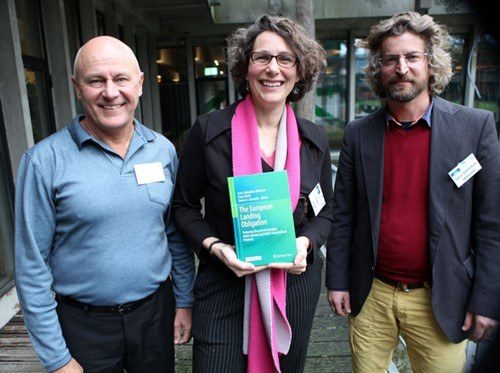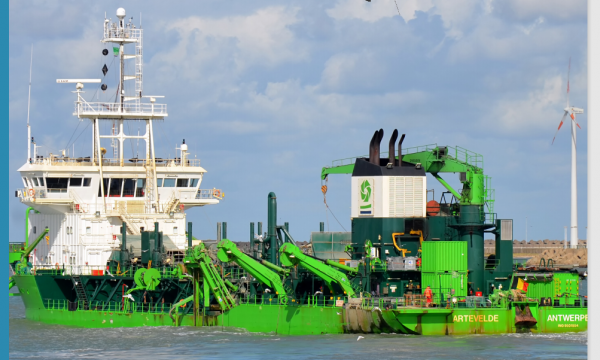Press release The Landing Obligation (Discard Ban) fully implemented starting in 2019

Beneficial effects on fish stocks only expected in the longer term and after correct implementation.
The Landing Obligation, which went into effect in all European fisheries from 1 January 2019 is indeed capable of achieving its goal, namely that Europe’s fisheries resources will become healthier. That is the conclusion of more than 100 specialized marine scientists, including Dr. Sebastian Uhlmann of ILVO, in a recently published scientific book, featuring the most recent research of the European Horizon2020 DiscardLess and Minouw projects, among others.
Origin and rollout of the Landing Obligation
The Landing Obligation was created in 2013 as an essential part of the reform of the Common Fisheries Policy. The big goal was to avoid discards of unwanted catch by requiring fishermen to bring them ashore. That sounds paradoxical, because in this way, it is possible that more fish deaths may occur. The survival rate of discards, which varies greatly among species, fishing practices and the environment, is after all now being reduced to zero for all species. In addition, fishermen must do more sorting and have to provide space for "worthless" fish. But the Landing Obligation still works: because of the extra work and the burden, fishermen are encouraged to avoid unwanted catches and thus reduce fishing pressure on fish stocks. Research and innovation therefore received a new impetus since 2015, the start of the introduction of the Landing Obligation. That introduction has occurred over several steps. Since 1 January 2019, the introduction of the Landing Obligation is now complete: professional fishermen in Europe now have to keep all undersized fish of species that fall under the quota system.
More selective fishing
"The best way to avoid discards is by not catching unwanted fish". This is the basic principle of selectivity research. Since there has been a Landing Obligation, scientists and fishermen have been developing several efficient fishing techniques that improve selectivity. That goes from the installation of escape panels in the nets to adjusting the size and shape of meshes. For example, the COMBItuig project is currently running in Flanders, where scientists and fishermen work together to determine which combination of measures gives the best results for specific vessels or fishing grounds. However, the possibilities of technical adjustments are limited, especially in mixed fisheries. Installing larger meshes to promote the escape of undersized fish will, for example, mean a loss of market-worthy and valuable sole.
According to researchers, there is even more benefit to be gained through tactical choices, i.e. the choice of place and time for fishing. "Hot spots for discards are mapped out through models and analysis of catches. This has already been done, for example, for sharks in the Azores and for codfish in the northern North Sea. Through such maps, fishermen can then avoid those places ", explains Sebastian Uhlmann. "But fish swim around and are therefore not always location-bound. That is why we must also consider the option of temporary closures, or 'real-time closures'. The principle is that fishermen who have a lot of bycatch at a certain location pass this information on to colleagues and coordinating bodies. That fishing ground can then be closed immediately and a lot of unwanted bycatch can be avoided. However, "There is still work to be done," says Uhlmann. "To be able to implement such “real-time closures”, you must be able to make a quick and objective analysis of the catch composition at that moment, and pass it on immediately. Camera systems and image analysis, in combination with satellite systems, could make that possible. And we are not talking here about checking to see if fishers are doing the right thing because that is not the task of a scientist. We suggest rather using and applying the technology purely to make fishing in the 21st century more efficient and sustainable."
What are the chances that fish will survive?
One research pathway stimulated by the Landing Obligation is the study of survival of fish caught. This comes from the premise that it would be a waste to land undersized fish that have a high chance of survival after being discarded. After all, these young fish could grow and spawn new fish. The Landing Obligation takes this into account and makes an exception if a high survival rate can be demonstrated for a species. For example, research in Flanders showed that the survival of plaice is highly dependent on, among other things, water temperature and on how long a net is towed over the bottom, and that the survival can be monitored via reflex tests on the fish. "The investigation is still ongoing and is being expanded," explains Uhlmann. "We not only want to determine survival, but also to predict and improve it, and do this for many species. For example, we recently started research on rays, a diverse group in which a number of rare and vulnerable species require additional monitoring and protection. Improving their chance for survival after being caught can be achieved by adapting procedures on board. For example, tests have been done with the installation of an extra discharge chute for undersized Norway lobster, so that they can quickly enter the water again after being handled on deck."
Avoiding 100% of unwanted catch is impossible
Despite all selectivity adjustments and exceptions, it is practically impossible to completely avoid the catch of unwanted fish, especially in mixed fisheries. So undersized fish are already being landed and that will continue to happen. "Because such fish cannot be sold for consumption, they must either be destroyed, or additional processing capacity must be built on land. In doing so, regional differences, such as small-scale fisheries in the Mediterranean and more industrial fisheries in the Atlantic, need to be taken into account. Although the Landing Obligation has already been fully rolled out, the processing of the unwanted fish is still in its infancy ", Uhlmann outlines. "In Flanders and Spain, for example, research was done on the fermentation of fish or silage for further application in the food and feed industry. The composition was examined for different types of fish, and preservation strategies were tested. That unwanted bycatch consists of different fish species is an extra challenge. That is why we are working on methods that make use of the genetic fingerprint of fish to identify them better."
Revising quota calculations
The Landing Obligation not only requires adjustments for fishermen, but also drastic changes are required on how fisheries are being managed. An important adjustment is, for example, the quota uplift. This is an increase in the quota, not as an aim to catch more, but to be able to charge against it the expected unwanted by-catch per species. This is done by ICES (International Council for the Exploration of the Sea). The distribution key of allowable catches between countries remains unchanged. In mixed fisheries, the inclusion of unwanted catch in the quota can cause major problems. For example, suppose there is one species in your catch for which you have no quota left, then you should immediately stop fishing, because you are not allowed to discard it anymore. This species then becomes a bottleneck or "choke species". "Research into strategies to deal with this is high on the priority list," explains Uhlmann. "Flexibility will be the key, for example by making it possible to exchange or trade quotas. For example, a fisherman should be allowed to buy or swap quota for a species at the moment that it may be choking his business. However, such systems are not allowed in all countries. For example, it is not possible in Belgium to trade quota among vessels, but in the Netherlands fishers can."
The economic picture of the Landing Obligation and the importance of full compliance.
More selective fishing or improving survival means investing in innovation, and taking unwanted catch back to shore means more frequent trips to port and therefore more fuel consumption. No matter how you look at it, the Landing Obligation entails additional costs. "This is confirmed by model predictions that were part of the European DiscardLess project, a large data source for the book," says Uhlmann. "In most of the scenarios under full implementation, earnings drop by 5% or more in 2025, even with the introduction of flexibility measures. On the other side of the balance sheet, we see that reducing the pressure on fish stocks opens the door to recovery, and thus better catch prospects in the longer term".
However, the precondition for this scenario of (limited) economic loss and recovering fish stocks is compliance and enforcement. Uhlmann: "At the moment, the weak spot of the policy is whether everyone is going to comply with the law." There is a suspicion that fishermen will continue to secretly discard, especially if it turns out that the costs of handling the by-catch are way too high. However, monitoring compliance is complicated by the fact that the regions and fleets differ greatly. "At the moment there is still a great deal of uncertainty about practical implementation and possible sanctions. What is already clear is that for proper enforcement a fast and reliable estimate of the composition of catches is required, preferably from a distance. In Canada, Australia and the United States, use is being made of camera systems on board. This is also being investigated in Europe.
More info:

